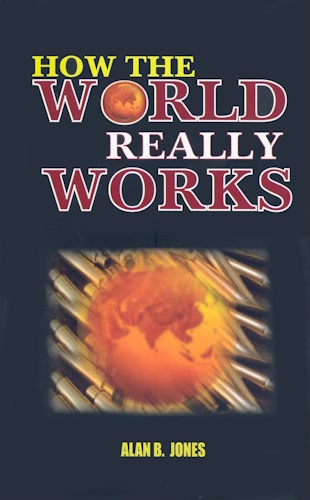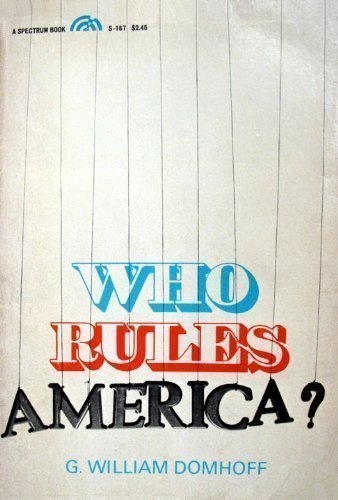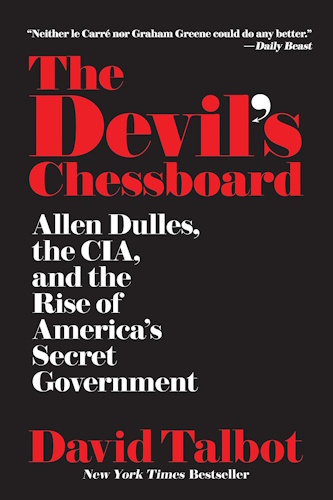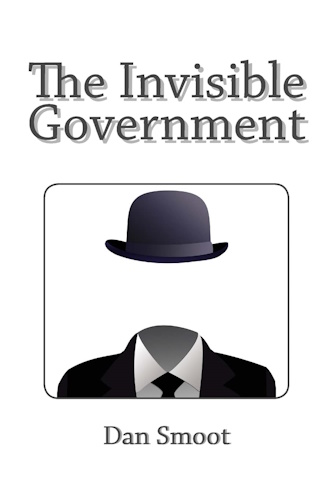












![]()
![]()
Preface: "THE SECRET TEAM II" 1997
PART ITHE SECRET TEAM
Chapter1The "Secret Team" -- the Real Power Structure
Chapter2The Nature of Secret Team Activity: A Cuban Case Study
PART IITHE CIA: HOW IT RUNS
Chapter3An Overview of the CIA
SectionI.Intelligence versus Secret Operations
SectionII.Origins of the Agency and
the Seeds of Secret Operations
SectionIII.A Simple Coup d'État to a Global Mechanism
Chapter4From the Word of the Law to the Interpretation:
President Kennedy Attempts to Put the CIA Under Control
Chapter5"Defense" as a National Military Philosophy,
the Natural Prey of the Intelligence Community
Chapter6"It Shall Be the Duty of the Agency: To Advise, to Coordinate,
to Correlate and Evaluate and Disseminate
and to Perform Services of Common Concern . . ."
Coordination of Intelligence -- the
Major Assigned Role of the CIA
Correlation, Evaluation and Dissemination of
Intelligence: Heart of the Profession
Services of Common Concern: An Attempt at Efficiency
Chapter7From the Pines of Maine to the Birches of Russia:
The Nature of Clandestine Operations
Chapter8CIA: "The Cover Story" Intelligence Agency
and the Real-Life Clandestine Operator
Chapter9The Coincidence of Crises
Chapter10The Dulles-Jackson-Correa Report in Action
PART IIITHE CIA: HOW IT IS ORGANIZED
Chapter11The Dulles Era Begins
Chapter12Personnel: The Chameleon Game
Chapter13Communications: The Web of the World
Chapter14Transportation: Anywhere in the World -- Now
Chapter15Logistics by Miracle
PART IVTHE CIA: SOME EXAMPLES
THROUGHOUT THE WORLD
Chapter16Cold War: The Pyrrhic Gambit
Chapter17Mission Astray, Soviet Gamesmanship
Chapter18Defense, Containment, and Anti-Communism
Chapter19The New Doctrine: Special Forces and
the Penetration of the Mutual Security Program
Chapter20Khrushchev's Challenge: The U-2 Dilemma
Chapter21A Time of Covert Action: U-2 to Kennedy Inaugural
Chapter22Camelot: From the Bay of Pigs to Dallas, Texas
Chapter23Five Presidents: "Nightmares We Inherited"
APPENDICES:
I. Definition of Special Operations
II. Powers and Duties of the CIA
III. Training Under the Mutual Security Program
. . . to Len Osanic and all at Bandit Productions for bringing all my work back to life.
. . . to Patrick Fourmy, Dave Ratcliffe and Tom Davis, old friends who have insisted I revise and re-write this old "classic".
. . . to Bill Mullan, Charlie Czapar, Bill Peters, and Dave Fleming, who worked with me in the Pentagon during the fifties, for those fascinating years with "Team B" in Headquarters, U.S. Air Force.
. . . to Charles Peters of The Washington Monthly for publishing the first "Secret Team" article, and Derek Shearer for breathing the whole concept into life.
. . . to General Graves B. (the big "E") Erskine and General Victor H. ("Brute") Krulak, both of the U. S. Marine Corps, my immediate "bosses" and good friends, in the Office of the Secretary of Defense and in the Office of the Joint Chiefs of Staff, for close personal relationships that shaped the course of these events.
. . . and to the hundreds of men with whom I shared these experiences and who must remain nameless and silent because that is the "code" of their chosen profession.
After I had given the manuscript of the original draft of this book to my editor at Prentice-Hall, in 1972; and had received the galley proof of the first edition back from him, he called me to suggest that I keep it in a safe place at all times. He told me that his home had been broken into the night before, and he suspected it was an attempt to steal his copy of that galley proof. He said, "They didn't get it. It was under the seat of the Volkswagon."
A few days later a nationwide release by the well-known Washington columnist, Jack Anderson, appeared across the country, "Book Bares CIA's Dirty Tricks". In that column, Anderson reported that the CIA had contacted a well-known bookstore in Washington and asked one of the employees to see if he could get a copy of the galley from me, and agreed to pay him $500, if he did. I agreed to meet him at my home that evening.
I suspected his call, but invited him anyway. In the meantime I set up a tape recorder in the umbrella stand near my front door and arranged for it to turn on when I switched on the overhead light on the front porch. With that arrangement, I recorded the whole visit including his final burst, "They promised me $500.00, if I got that galley proof." I took that tape to Anderson, and it was the basis of his March 6, 1973 column. The underground attack didn't quit there.
After excellent early sales of The Secret Team during which Prentice-Hall printed three editions of the book, and it had received more than 100 favorable reviews, I was invited to meet Ian Ballantine, the founder of Ballantine Books. He told me that he liked the book and would publish 100,000 copies in paperback as soon as he could complete the deal with Prentice-Hall. Soon there were 100,000 paperbacks in bookstores all around the country.
Then one day a business associate in Seattle called to tell me that the bookstore next to his office building had had a window full of books the day before, and none the day of his call. They claimed they had never had the book. I called other associates around the country. I got the same story from all over the country. The paperback had vanished. At the same time I learned that Mr. Ballantine had sold his company. I traveled to New York to visit the new "Ballantine Books" president. He professed to know nothing about me, and my book. That was the end of that surge of publication. For some unknown reason Prentice-Hall was out of my book also. It became an extinct species.
Coincidental to that, I received a letter from a Member of Parliament in Canberra, Australia, who wrote that he had been in England recently visiting in the home of a friend who was a Member of the British Parliament. While there, he discovered The Secret Team on a coffee table and during odd hours had begun to read it.
Upon return to Canberra he sent his clerk to get him a copy of the book. Not finding it in the stores, the clerk had gone to the Customs Office where he learned that 3,500 copies of The Secret Team had arrived, and on that same date had been purchased by a Colonel from the Royal Australian Army. The book was dead everywhere.
The campaign to kill the book was nationwide and world-wide. It was removed from the Library of Congress and from College libraries as letters I received attested all too frequently.
That was twenty years ago. Today I have been asked to rewrite the book and bring it up to date. Those who have the book speak highly of it, and those who do not have it have been asking for it. With that incentive, I have begun from page one to bring it up to date and to provide information that I have learned since my first manuscript.
In the beginning, this book was based upon my unusual experience in the Pentagon during 1955-1964 and the concept of the book itself was the outgrowth of a series of luncheon conversations, 1969-1970, with my friends Bob Myers, Publisher of the New Republic, Charlie Peters, founder of The Washington Monthly, and Ben Schemmer, editor and publisher of the Armed Forces Journal, and Derek Shearer. They were all experienced in the ways and games played in Washington, and they tagged my stories those of a "Secret Team." This idea grew and was polished during many subsequent luncheons.
After my retirement from the Air Force, 1964, I moved from an office in the Joint Chiefs of Staff area of the Pentagon to become Manager of the Branch Bank on the Concourse of that great building. This was an interesting move for many reasons, not the least of which was that it kept me in business and social contact with many of the men I had met and worked with during my nine years of Air Force duties in that building. It kept me up-to-date with the old "fun-and-games" gang.
After graduating from the Graduate School of Banking, University of Wisconsin, I transfered to a bank in Washington where in the course of business I met Ben Schemmer. He needed a loan that would enable him to acquire the old Armed Forces Journal. During that business process I met two of Ben's friends Bob Myers and Charlie Peters. We spent many most enjoyable business luncheons together. This is where "The Secret Team" emerged from a pattern of ideas to a manuscript.
As they heard my stories about my work with the CIA, and especially about the role of the military in support of the world-wide, clandestine operations of the CIA, they urged me to write about those fascinating nine years of a 23-year military career. During the Spring of 1970 I put an article together that we agreed to call "The Secret Team", and Charlie Peters published it in the May 1970 issue of The Washington Monthly.
Before I had seen the published article myself, two editors of major publishers in New York called me and asked for appointments. I met with both, and agreed to accept the offer to write a book of the same name, and same concept of The Secret Team from Bram Cavin, Senior Editor with Prentice-Hall.
After all but finishing the manuscript, with my inexperienced typing of some 440 pages, I sat down to a Sunday breakfast on June 13, 1971 and saw the headlines of the New York Times with its publication of the "purloined" Pentagon Papers.1 One of the first excerpts from those papers was a TOP SECRET document that I had worked on in late 1963. Then I found more of the same. With that, I knew that I could vastly improve what I had been writing by making use of that hoard of classified material that "Daniel Ellsberg had left on the doorstep of the Times," and other papers. Up until that time I had deliberately avoided the use of some of my old records and copies of highly classified documents. The publication of the Pentagon Papers changed all that. They were now in the public domain. I decided to call my editor and tell him what we had with the "Pentagon Papers" and to ask for more time to re-write my manuscript. He agreed without hesitation. From that time on I began my "Doctorate" course in, a) book publishing and, b) book annihilation.
As we see, by some time in 1975 The Secret Team was extinct; but unlike the dinosaur and others, it did not even leave its footprints in the sands of time. There may be some forty to fifty thousand copies on private book shelves. A letter from a professor informed me that his department had ordered more than forty of the books to be kept on the shelves of his university library for assignment purposes. At the start of the new school year his students reported that the books were not on the shelves and the registry cards were not in the master file. The librarians informed them that the book did not exist.
With that letter in mind, I dropped into the Library of Congress to see if The Secret Team was on the shelves where I had seen it earlier. It was not, and it was not even in that library's master file. It is now an official non-book.
I was a writer whose book had been cancelled by a major publisher and a major paperback publisher under the persuasive hand of the CIA. Now, after more than twenty years the flames of censorship still sweep across the land. Despite that, here we go again with a new revised edition of The Secret Team.
Footnotes
1. Any reader of the "Pentagon Papers" should be warned that although they were commissioned on June 17, 1967, by the Secretary of Defense as "the history of United States involvement in Vietnam from World War II [Sept 2, 1945] to the present" [1968], they are unreliable, inaccurate and marred by serious omissions. They are a contrived history, at best, even though they were written by a selected Task Force under Pentagon leadership.
This 1997 edition of the book is available in its entirety on Len Osanic's rip-roaring 1997 CD-ROM, The Collected Works of Col. L. Fletcher Prouty along with ~600MB of 70+ articles, 100 images, 30 topics and 6 hours of audio material. Read all about it and how to order your own copy by going to: www.prouty.org
The online copy of this book was made possible by the efforts and generosity of Len Osanic. We thank him for his support. Be sure to check out the details on the complete CD if you are interested in this book. There is a great deal to recommend it for anyone who wants to study the writings, interviews and perceptions of Colonel Prouty. The significance of Prouty's level and depth of first-hand experience of World War II and direct participation in the ensuing birth and rise of the National Security State is provided in great detail on The Collected Works CD.












-
Urantia Book, 44:0.11 - The Celestial Artisans
Never in your long ascendancy will you lose the power to recognize your associates of former existences. Always, as you ascend inward in the scale of life, will you retain the ability to recognize and fraternize with the fellow beings of your previous and lower levels of experience. Each new translation or resurrection will add one more group of spirit beings to your vision range without in the least depriving you of the ability to recognize your friends and fellows of former estates.
-
Princess Bride 1987 Wallace Shawn (Vizzini) and Mandy Patinkin (Inigo Montoya)
Vizzini: HE DIDN'T FALL? INCONCEIVABLE.
Inigo Montoya: You keep using that word. I do not think it means what you think it means. -
Urantia Book, 117:4.14 - The Finite God
And here is mystery: The more closely man approaches God through love, the greater the reality -- actuality -- of that man. The more man withdraws from God, the more nearly he approaches nonreality -- cessation of existence. When man consecrates his will to the doing of the Father's will, when man gives God all that he has, then does God make that man more than he is.
-
Urantia Book, 167:7.4 - The Talk About Angels
"And do you not remember that I said to you once before that, if you had your spiritual eyes anointed, you would then see the heavens opened and behold the angels of God ascending and descending? It is by the ministry of the angels that one world may be kept in touch with other worlds, for have I not repeatedly told you that I have other sheep not of this fold?"
-
Urantia Book, Foreword - 0:12.12 - The Trinities
But we know that there dwells within the human mind a fragment of God, and that there sojourns with the human soul the Spirit of Truth; and we further know that these spirit forces conspire to enable material man to grasp the reality of spiritual values and to comprehend the philosophy of universe meanings. But even more certainly we know that these spirits of the Divine Presence are able to assist man in the spiritual appropriation of all truth contributory to the enhancement of the ever-progressing reality of personal religious experience—God-consciousness.
-
Urantia Book, 1:4.3 - The Mystery Of God
When you are through down here, when your course has been run in temporary form on earth, when your trial trip in the flesh is finished, when the dust that composes the mortal tabernacle "returns to the earth whence it came"; then, it is revealed, the indwelling "Spirit shall return to God who gave it." There sojourns within each moral being of this planet a fragment of God, a part and parcel of divinity. It is not yet yours by right of possession, but it is designedly intended to be one with you if you survive the mortal existence.
-
Urantia Book, 1:4.1 - The Mystery Of God
And the greatest of all the unfathomable mysteries of God is the phenomenon of the divine indwelling of mortal minds. The manner in which the Universal Father sojourns with the creatures of time is the most profound of all universe mysteries; the divine presence in the mind of man is the mystery of mysteries.
-
Urantia Book, 1:4.6 - The Mystery Of God
To every spirit being and to every mortal creature in every sphere and on every world of the universe of universes, the Universal Father reveals all of his gracious and divine self that can be discerned or comprehended by such spirit beings and by such mortal creatures. God is no respecter of persons, either spiritual or material. The divine presence which any child of the universe enjoys at any given moment is limited only by the capacity of such a creature to receive and to discern the spirit actualities of the supermaterial world.
-
Urantia Book, 11:0.1 - The Eternal Isle Of Paradise
Paradise is the eternal center of the universe of universes and the abiding place of the Universal Father, the Eternal Son, the Infinite Spirit, and their divine co-ordinates and associates. This central Isle is the most gigantic organized body of cosmic reality in all the master universe. Paradise is a material sphere as well as a spiritual abode. All of the intelligent creation of the Universal Father is domiciled on material abodes; hence must the absolute controlling center also be material, literal. And again it should be reiterated that spirit things and spiritual beings are real.
-
Urantia Book, 50:6.4 - Planetary Culture
Culture presupposes quality of mind; culture cannot be enhanced unless mind is elevated. Superior intellect will seek a noble culture and find some way to attain such a goal. Inferior minds will spurn the highest culture even when presented to them ready-made.
-
Urantia Book, 54:1.6 - True And False Liberty
True liberty is the associate of genuine self-respect; false liberty is the consort of self-admiration. True liberty is the fruit of self-control; false liberty, the assumption of self-assertion. Self-control leads to altruistic service; self-admiration tends towards the exploitation of others for the selfish aggrandizement of such a mistaken individual as is willing to sacrifice righteous attainment for the sake of possessing unjust power over his fellow beings.
-
Urantia Book, 54:1.9 - True And False Liberty
How dare the self-willed creature encroach upon the rights of his fellows in the name of personal liberty when the Supreme Rulers of the universe stand back in merciful respect for these prerogatives of will and potentials of personality! No being, in the exercise of his supposed personal liberty, has a right to deprive any other being of those privileges of existence conferred by the Creators and duly respected by all their loyal associates, subordinates, and subjects.
-
Urantia Book, 54:1.8 - True And False Liberty
There is no error greater than that species of self-deception which leads intelligent beings to crave the exercise of power over other beings for the purpose of depriving these persons of their natural liberties. The golden rule of human fairness cries out against all such fraud, unfairness, selfishness, and unrighteousness.



